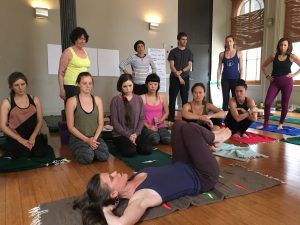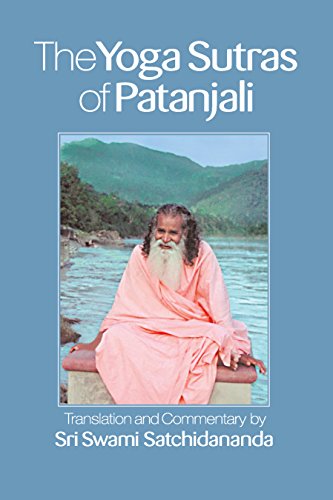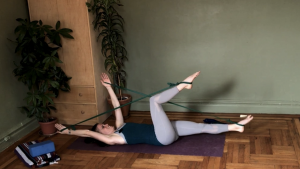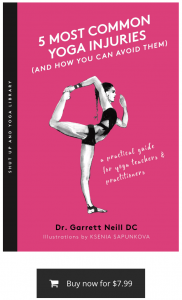I recently hosted a five-day online challenge, sharing with students various ways to combine resistance bands and yoga. I got tons of encouraging feedback, but as usual, it was the negative response that stuck in my mind. This comment stopped me in my tracks: “Add Patanjali and the Gita, now that would be really revolutionary.”
“Add Patanjali and the Gita, now that would be really revolutionary.”
I was triggered by this comment. What I heard was, “You don’t belong here.” I heard, “Your yoga isn’t real.” It reminded me of the fundamentalism of my conservative Christian upbringing. Memories marked, most notably, by a shame-based gap between believers and unbelievers, an us-versus-them mentality.
What I heard was, “You don’t belong here.” I heard, “Your yoga isn’t real.”
As a yoga teacher, I share a wide variety of movements in my classes: self-massage using therapy balls, interdisciplinary movement inspired by systems like Pilates, Feldenkrais, and weight-training, plus (surprisingly hard) developmental movements we, humans, tend to forget once we grow up (think: crawling, squatting, rolling over). These modalities gave me a new vocabulary to express yoga ’s essential teaching: a sense of wholeness and integration.
I’m not alone in adapting yoga asana this way. I see this in the huge array of modern interpretations of “yoga”. The studio where I teach in New York City offers its own proprietary method of asana, blending a mix of lineages, plus vinyasa, power, restorative, and hatha yoga, all at a variety of levels, some of which include meditation. A few blocks away is an Iyengar studio with a non-traditional wall of ropes; further north you’ll find a more classic center for bhakti yoga; dotted around town, there are hot yoga studios, ones that blast hip-hop music in the dark, and others that incorporate weights. Some teachers chant and light incense, and some instruct how to engage muscles to improve motor control and alter pain signals.

Why are these interpretations of yoga so different? Do all have the potential to help us work through addictive states of mind like dissociation, distraction, or anxiety?
Why are these interpretations of yoga so different?
Given the constant challenges our society presents to our physical and mental well-being, like encouraging sedentarism and social media, many of us experience feeling “disconnected” from certain aspects of ourselves. Our minds race, our backs hurt, our relationships suffer. When we breathe and move mindfully, we become aware of the source of these feelings of disconnect, how the seemingly separate aspects of ourselves work together, and how we can learn to feel more whole and at ease. Some call this “yoga.”
The concept of yoga is mentioned in a variety of yogic texts, including the two cited by my critic, Patanjali’s Yoga Sutras and The Bhagavad Gita. One translation of the Sutras defines yoga as the stilling of the fluctuations of the mind. The Bhagavad Gita uses the word yoga over a 100 times with around 10 possible meanings, from discernment to sacrifice to determined force. So it should come as no surprise that practitioners interpret the word yoga quite personally. We can all agree that the state of yoga is something felt rather than seen or measured.

Not surprisingly, practitioners interpret the word yoga quite personally.
Asana is one tool to help us become more self-aware. But getting too caught up in the specifics of the physical practice, forgetting that we’re all working to get to the same place, can cause problems. Trying to keep things traditional can lead us to sacrifice the ultimate goal– if you do a dozen chaturangas in a class because it’s the “right” thing to do, but leave with sore shoulders and wrists, has that really helped you achieve a state of yoga?
To my mind, the end should define the means. If we ultimately want to experience connection, then the tools we choose should explore connection from the start. And tools aren’t set in stone.
If the traditional physical practices or philosophies associated with yoga don’t address my needs, or if they contribute to pain, injury, or disconnect, I ask myself how I can adapt them. And in reality, we started changing yoga as soon as we chose not to live in ashrams, as the yogi ascetics of Patanjali’s time did. Our needs have changed, and yoga has changed with it.
Our needs have changed, and yoga has changed with it.
If we only look at The Yoga Sutras, we get a limited understanding of yoga. For example, Sutras, say that we can only know our “true Selves” when we have disassociated our identities from everything including our relationships, our bodies, and our environment. This goal runs in direct contrast to what practitioners commonly express as their reasons for doing yoga: to nurture connection to themselves, each other, and the world.
There are problematic ideals communicated in every spiritually authoritative text. But it’s important that we understand what makes us uncomfortable about an established philosophy or system before propagating its ideas. I’d rather be deeply engaged in inquiry than to simply “let go” of making meaning for myself. For me, making healthy boundaries and decisions requires putting our faith in progress, rather than relinquishing it to a guru or dogma.
So when I ask myself “what does yoga mean?” I cannot simply look to texts for the answers. To practice earnestly, I must ask if I am interpreting it and sharing it in the ways that are most relevant to the people I’m trying to help. Do I know yoga by standing outside of its description on a page, or by feeling it from inside of my body and mind?

Do we know yoga by standing outside of its description on a page, or feeling it from inside our bodies and minds?
For me, heightened intentionality, sensitivity, and discernment have been the positive outcomes of my practice, my personal “state of yoga,” whether I practiced traditional asana or lifted weights at the gym. As long as I’ve been willing to stay in the discomfort of ambiguity, I’ve connected to what is actually happening in the gray. While this state of ambivalence doesn’t necessarily ease suffering, my yoga practice has contributed to a feeling that I am whole and complete in the absence of clear-cut answers. An absolutist approach, such as sticking only to traditional asana poses, has rarely offered me this feeling in the long term. Yoga as a set of tools has helped me regulate myself enough to be able to sit comfortably, question and evolve the very techniques that helped me find more integration.
Yoga as a set of tools has helped regulate me enough to be able to sit comfortably, question and evolve the very techniques that resulted in this more integrated state.
Encounters like that student’s comment remind me of why I teach yoga at all: to encourage critical thinking, to soften certainty, to engage gluteus maximus, and ultimately to make space for questions. To overcome ignorance by questioning traditional ideas, and then either re-imagining them or leaving them behind. I choose to call what I practice and teach yoga, because of all the spiritual practices I’ve engaged with, yoga has helped me the most, despite its flaws.
Embracing my interpretation of yoga, and surrounding myself with others who do the same, has helped me integrate what felt before like separate pieces of myself. I’ve shaped the tool as much as it has shaped me, and I encourage you to explore doing the same in your practice.
RESOURCES
Weight Training with Free Weights and/or Kettlebells
Classically, yoga asanas are practiced using body weight only. For this reason, lifting weights provides a key missing ingredient in many yoga practitioners’ ‘movement diets’ which is to externally load the body, or to move against external resistance. To learn to lift weights, I recommend hiring a strength coach. An experienced trainer can assess your technique and help you find an optimal position, as well as help you understand how to progressively load your body safely over time.
Yoga with Resistance Bands
These are my signature yoga classes in which every pose of the sequence incorporates one or more resistance bands. Classes progress in a logical way toward a peak posture. These classes offer yoga practitioners an opportunity to externally load their bodies against the resistance of stretchy bands while still practicing the asanas (and other interdisciplinary movements.) The resistance bands completely change the physical experience of practicing by providing new feedback to your nervous system, feedback that challenges you to get stronger, but also helps you better sense your body position in space. For this reason, Yoga with Resistance Bands is especially helpful for hypermobile practitioners. You can find these classes on my website.

Feldenkrais
Feldenkrais is a movement system that provides you with the time and space to make discoveries around common and specific human movement patterns. I’ve left Feldenkrais classes feeling more deeply relaxed and grounded than most asana classes. The teachers cue in a way that invites awareness and discovery, and that highlights the interoceptive perspective of movement. These classes put you in touch with what a movement feels like and guide you progressively through the process of discovering what else is possible to feel. I always have huge ‘aha!’ moments where suddenly something I’ve been doing for a long time feels brand new again as if I’m doing it for the first time.
Self-Massage (The Roll Model® Method)
Self-massage offers a more diverse way to passively stretch the body’s tissues in a manner that many also find deeply relaxing to the nervous system. Massage is known to be an effective way to improve flexibility but also an effective analgesic to pain. I practice and teach the Roll Model®️ Method, which is a comprehensive self-massage training program that prepares you to both practice and teach self-massage utilizing a variety of different therapy balls and a complete framework of techniques to apply.

Pilates on the Reformer
The Pilates reformer is a piece of equipment that uses spring-based resistance for exercises designed to improve core control, global strength, posture, and mobility. Pilates teachers provide specific instruction to help students learn how to control their body position and become more stable through full expressions of joint range of motion.
FRC® (Functional Range Conditioning)
FRC is a mobility system that helps practitioners acquire and enhance their active, useable range of motion. Through exploring full expressions of joint range of motion in a slow, controlled manner, practitioners learn to move more freely in the ways they don’t move easily. This improves joint resiliency and increases movement options in daily life. Finally, FRC helps to train new motor control patterns in the nervous system, which is an effective strategy for reducing pain and improving performance.
Edited by Jaimee Hoefert




